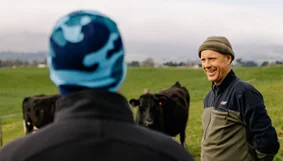Improving our business sustainability by measuring and reducing our greenhouse gas emissions and supporting our staff and suppliers to do the same, is an important part of our commitment to a greener tomorrow.
We’re proud to be a signatory of the Climate Leaders Coalition and are committed to making improvements within our business to become carbon neutral by 2050.
What we’re doing to improve business sustainability
We recognise the need for collective action on climate change and are undergoing some key initiatives to make sure we’re playing our part. Take a look at our latest Sustainability Report for more details about what we are working on as a company and how we're supporting the New Zealand dairy sector.
Our climate risks and opportunities
As a NZX listed company, LIC is a Climate Reporting Entity and will report under the External Reporting Board’s Climate-related Disclosure Framework from the 2023/24 reporting year.
We have also adopted the Climate Leaders Coalition Statement of Ambition, which includes:
- Measuring our emissions, having them independently verified, and reporting them publicly;
- Adopting short-and-long-term gross absolute science aligned targets for scope 1, 2, and 3 emissions to support the delivery of substantial reductions needed to limit future warming to 1.5 degrees Celsius;
- Assessing climate change risks and opportunities (including in the value chain), setting objectives and/or target(s) to reduce these risks and maximise opportunities, and publicly disclosing them; and
- Proactively enabling our employees, board members, customers, and suppliers to reduce their emissions and climate change risks.
We have considered LIC’s primary physical climate risks and opportunities based on the National Climate Change Risk Assessment for Aotearoa New Zealand:
- Economy
- Risks to land-based primary sector productivity and output due to changes in mean rainfall and temperature, seasonality, weather extremes and changes in the distribution of invasive species (E3)
- Risks to businesses and public organisations from supply chain and distribution network disruptions, due to extreme weather events and ongoing, gradual changes (E7)
- Human – Risks to physical health from exposure to storm events, heatwaves, vector-borne and zoonotic diseases, water availability and resource quality and accessibility, due to changes in temperature, rainfall and extreme weather events (H3)
- Built environment
- Risk to potable water supplies (availability and quality) due to changes in rainfall, temperature, drought, extreme weather events and ongoing sea-level rise (B1)
- Risks to linear transport networks, due to changes in temperature, extreme weather events and ongoing sea-level rise (B6)
- Risks to electricity infrastructure, due to changes in temperature, rainfall, snow, extreme weather events, wind and increased fire weather (B8)
Our emissions and energy
We first measured our emissions in the 2018 financial year (1 June 2018 – 31 May 2019). These measurements serve as our base year for all future emissions to be compared against.

Science-based emissions targets
We have defined the following science-based climate change targets to reduce our greenhouse gas emissions against our 2018/19 base year and limit the temperature increase to 1.5°C of pre-industrial levels:
- 46.2% reduction of Scope 1 and 2 emissions* by 2030
- 28.88% reduction of Scope 3 emissions* by 2030
- 10% reduction of biogenic methane by 2030
*Excluding biogenic methane
Scope 1 – Direct GHG emission sources
Direct emissions are generated by sources owned or controlled by us. For example, emissions from our fleet vehicles, and agriculture emissions from our farms.
Scope 2 – Indirect GHG emission sources
Indirect emissions are derived from the generation of purchased electricity that is used by LIC.
Scope 3 – Other GHG indirect emission sources
Other indirect emissions are derived from the activities that are carried out by us but from sources not controlled by us. For example, indirect emissions from staff vehicles used to travel to and from work.
Scope 1 – Biogenic methane
Scope 1 biogenic methane emissions are generated from enteric fermentation, manure from our cows and bulls, and from onsite wastewater treatment.
Scope 3 – Biogenic methane
Scope 3 biogenic methane emissions are generated from municipal wastewater treatment and waste.



